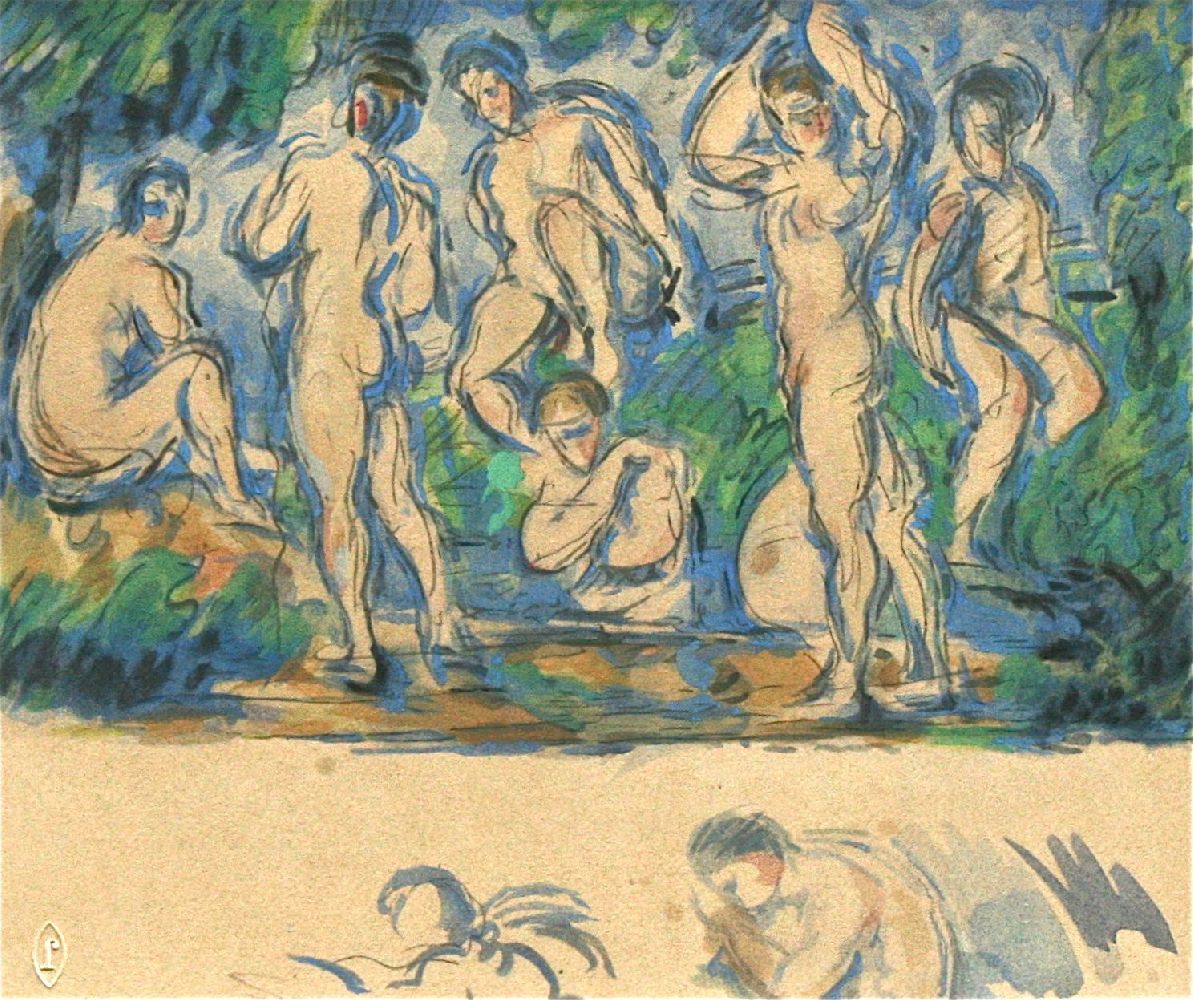

Title: Les Baigneuses Watercolor Lithograph Print Artist Paul Cezanne
Shipping: $25.00
Artist: N/A
Period: 19th Century
History: N/A
Origin: N/A
Condition: Museum Quality
Item Date: 1885-1890
Item ID: 5234
Nude Bathers, Still Life. These prints are from a portfolio, watercolor Print Lithographs from the artist Paul Cezanne: 1839-1906. Artist: Cezanne French, 1885-1890). Watercolor and pencil on paper. Title: Les Baigneuses, Year: 1947, Medium: Lithograph, Edition: 194/500, Works On Paper Montage. The contribution made by Paul Cézanne's work is unequalled in the history of 20th-century art and painting. It was pivotal and left its imprint on artistic movements which were as seminal as they were diverse: Cubism, Fauvism and Abstraction. Treating each aspect of his compositions with the same thoroughness, refusing to impose any hierarchy on his subjects, Cézanne was the source of a new representation of perspective which his successors would use to open the floodgates of Modern Art. "Cézanne went solely towards the abstraction of natural bodies. recognised as key masterpieces, "among the most difficult works of art [to access] and yet the most powerful in the history of the early 20th century We know that Cézanne undertook a number of studies and drafts of "women bathing beneath the trees, in a field", this "subject which haunted him". "Most are pencil sketches which would not leave the chest-of-drawers in his bedroom or the draw of the table in his studio, testifying to his tenacity and even a certain determination to address the theme". There are currently only a small number of studies catalogued, however, that reflect the same composition as in the final versions, notably including seven studies. There are sets of watercolours, a large majority of which are now owned by public institutions. By addressing the theme of male bathers on the 1870s, and then female bathers a decade later, Cézanne follows in the long 17th and 18th century tradition of mythology and Classicism, placing nudes in open-air compositions in the manner of Titian or Poussin. However, while the artist seems to find inspiration in a Classical theme, he nevertheless offers a complete and very personal reinterpretation of it. In these prints, he attempts to achieve perfect harmony, the merging of figures and natural elements, both through his use of tone and form. The importance given to the landscape, both in terms of the space allocated to it and the special attention paid to the tonality of the water, sky and foliage, creating a feeling of depth with the greatest possible minimalism, is reminiscent of his work. Most of this work, which has remained unknown to the general public until now.
Link: http://en.wikipedia.org/wiki/Paul_C%C3%A9zanne
Paul Cézanne French: [pɔl sezan]; 1839–1906) was a French artist and Post-Impressionist painter whose work laid the foundations of the transition from the 19th century conception of artistic endeavour to a new and radically different world of art in the 20th century. Cézanne can be said to form the bridge between late 19th century Impressionism and the early 20th century's new line of artistic enquiry, Cubism. The line attributed to both Matisse and Picasso that Cézanne "is the father of us all" cannot be easily dismissed.
Cézanne's often repetitive, sensitive and exploratory brushstrokes are highly characteristic and clearly recognizable. He used planes of colour and small brushstrokes that build up to form complex fields, at once both a direct expression of the sensations of the observing eye and an abstraction from observed nature. The paintings convey Cézanne's intense study of his subjects, a searching gaze and a dogged struggle to deal with the complexity of human visual perception.
Cézanne's paintings were not well received among the petty bourgeoisie of Aix. In 1903 Henri Rochefort visited the auction of paintings that had been in Zola's possession and published on 9 March 1903 in L'Intransigeant a highly critical article entitled “Love for the Ugly”. Rochefort describes how spectators had supposedly experienced laughing fits, when seeing the paintings of “an ultra-impressionist named Cézanne”. Erroneously believing that Cézanne's paintings in fact represented “the art dear to Zola” (Rochefort's Dreyfusard arch-enemy), he drew connections between “Dreyfusard snobs”, the French officer who was accused but innocent of having sold defense plans to the fatherland and Zola's supposedly cherished artist, Cézanne. The public in Aix was overwhelmed with joy, and for many days, copies of L'Intransigeant appeared on Cézanne's door-mat with messages asking him to leave the town “he was dishonouring”.
One day, Cézanne was caught in a storm while working in the field. Only after working for two hours under a downpour did he decide to go home; but on the way he collapsed. He was taken home by a passing driver. His old housekeeper rubbed his arms and legs to restore the circulation; as a result, he regained consciousness. On the following day, he intended to continue working, but later on he fainted; the model with whom he was working called for help; he was put to bed, and he never left it again. He died a few days later, on 22nd October 1906. He died of pneumonia and was buried at the old cemetery in his beloved hometown of Aix-en-Provence.